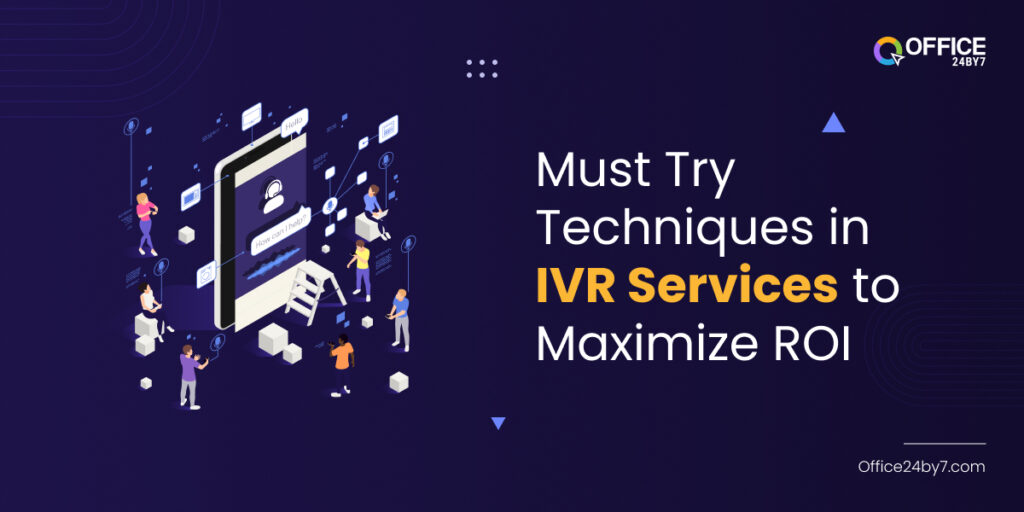
Imagine you’re managing a restaurant. You greet the customers warmly at the door, seat them comfortably, and present them with a lavish menu with tempting options. You ensure fast serving of orders, create a fine dining experience, and do anything to make sure they are truly satisfied. How do you measure their satisfaction? Easy – you read it from their faces and gestures. But what if you’re managing a virtual business, where your customers interact solely through IVR (Interactive Voice Response) systems? In this scenario, you can’t capture customers’ facial expressions or gestures as they can be miles away. This is why analyzing the output of IVR services in cloud call center solutions is important. By analyzing the tracking metrics and optimizing them, interactions with the IVR services can be improved to elevate customer satisfaction, and ultimately, increase ROI (return on investment).
Leveraging IVR services has become increasingly important for organizations aiming to improve customer satisfaction. However, merely implementing IVR systems is not enough to ensure maximum ROI. Businesses need to integrate robust tracking and IVR analytics capabilities into their systems to truly discover the benefits of IVR services. This article explores how organizations can maximize their ROI from IVR services through effective techniques for tracking and IVR analytics.
- What are IVR Services?
- Major Components of IVR Services
- The Role of Analytics in Cloud Call Center Solutions
- Techniques to Leverage Analytics to Increase ROI
- Techniques to Enhance Marketing Through IVR Services
- Techniques for Continuous Improvement in IVR Services
What are IVR Services?
Let’s take a look at the fundamentals of IVR services before we dig deeper into the subject. IVR services are a part of the telephony system that enables the callers to interact with the business through an IVR number. Callers provide keypad inputs or voice prompts as per the instructions they hear through inbound call center services. IVR systems recognize these touch and voice tones to route them. The menu of an IVR service can include self-service options, information service, escalation to live agents, and much more. This technology helps organizations to enhance customer experience and optimize resource utilization.
Major Components of IVR Services
There are several concepts in IVR services that one should understand before learning more about IVR analytics.:
| Concept | Description |
| Virtual Number | A virtual number service helps display an IVR number on the company’s website, mobile application, or other marketing materials. Customers can dial this number to reach the business. Virtual number service helps businesses project a local business presence while running the business globally. Usually, virtual number service comes in landline, mobile, and toll-free number formats. |
| IVR Menu | The primary interface through which callers interact with the call center IVR systems. These menus present options to navigate through various services or departments by giving commands via touch-tone keypad or voice prompts. |
| IVR Scripting | IVR scripting is the designing and implementing of the flow for the IVR system. This includes crafting prompts, recording voice prompts, defining menu options, and building the logic to guide callers through the interaction. |
| DTMF (Dual-Tone Multi-Frequency) Input | DTMF input involves using the keypad on a phone to input commands by pressing keys corresponding to different options presented in the IVR menu. |
| Speech Recognition | This technology enables callers to interact with the system using natural language instead of touch-tone input. Virtual call center software interprets spoken words and phrases to route them and enhance customer satisfaction. |
| Call Routing | Call routing is the process of directing inbound call center services to the appropriate destination within the organization based on predefined criteria. |
| Integrations | IVR services often integrate with other systems or tools like CRM (Customer Relationship Management) systems and other business applications. This helps access customer information and offers more broad services. |
| Call Tracking and Analytics | A good IVR service provider often provides tools to track and analyze IVR interactions. This call tracking and analytics helps gather insights into caller behavior, identify trends, and measure the effectiveness of IVR menus and scripts. Organizations can use this to optimize their IVR services for better customer satisfaction. |
The Role of Analytics in Cloud Call Center Solutions
Customer expectations are evolving rapidly due to the increased availability of options around them. Most customers no longer wait for the business to give an explanation if they are not satisfied with the service. According to a recent research by Microsoft Dynamics 365, “a whopping 95% of consumers say that customer service is essential for brand loyalty, and 60% of consumers report having deserted a brand and switching to a rival company because of poor customer service”. They simply go to a competitor as the market is so wide with alternatives. Therefore, organizations increasingly turn to cloud call center solutions to streamline operations and enhance customer service. Cloud call center solutions offer flexibility, scalability, and cost-effectiveness through IVR services, making them an attractive option for businesses of all sizes. However, the true value of IVR solutions lies in the insights derived from call tracking and analytics.
Analytics in IVR services refers to the process of collecting, analyzing, and interpreting data generated by customer interactions with the call center IVR systems. These analytics offer invaluable insights into caller behavior, demographics, IVR flow effectiveness, performance, and overall customer satisfaction. Businesses can use this to make data-driven decisions and identify areas for improvement. This will help them to optimize IVR workflows to ultimately boost customer satisfaction, which further helps to increase marketing ROI.
Let us categorize the ROI maximization techniques in IVR services into three broad categories:
- Techniques to leverage analytics to increase ROI
- Techniques to enhance marketing through IVR services
- Techniques for continuous improvement in IVR services
Techniques to Leverage Analytics to Increase ROI
Analytics are essential for every domain, and the same goes for virtual call center software. Analyzing data from cloud call center solutions for insights and implementing strategic optimizations are essential for organizations. This helps them maximize ROI from their IVR services. Let’s explore how businesses can leverage analytics to enhance IVR performance and drive greater returns:
Analyze Data from IVR Services for Insights
The effectiveness of cloud call center solutions in creating customer satisfaction can be measured using several metrics. These include containment rate, transfer rate, opt-out rate, call abandonment rate, average call duration, customer satisfaction score (CSAT), error rate, call volume, caller demographics, etc. The most effective way to increase ROI from IVR services is by analyzing the data generated by customer interactions with the system. These advanced call tracking and analytics tools and techniques help organizations achieve valuable insights into caller behavior, preferences, and pain points. Analyzing IVR data allows businesses to identify trends, patterns, and opportunities for improvement.
Leveraging this data can help you identify:
- emerging customer needs,
- anticipate seasonal fluctuations in call volumes,
- track the effectiveness of promotions,
- peak times of caller inquiries,
- average customer behavior, and
- major reasons for customer frustration.
Patterns in caller demographics may reveal shifts in target audience demographics or regional preferences. It can guide adjustments to IVR prompts and menu options to better align with customer expectations.
Improve CSAT Score
Analyzing trends in CSAT over time can provide insights into the impact of IVR system enhancements on overall customer sentiment. CSAT is an important metric to assess the effectiveness of implementing an IVR number in meeting customer expectations and needs. A high CSAT score indicates that customers are satisfied with their interactions with the IVR system, while a low score may signal areas for improvement. Here are some strategies to improve CSAT scores and enhance overall customer satisfaction:
- Streamline navigation: Simplify IVR menus and prompts to make it easier for customers to navigate through options.
- Personalize the experience: Tailor IVR interactions with individual callers based on their history, preferences, and past interactions with the organization.
- Provide self-service options: Offer a wide range of self-service options within the IVR system to empower customers to resolve their inquiries independently.
- Optimize call routing: Implement intelligent call routing algorithms to ensure that callers are connected to the most appropriate departments based on their inquiries.
- Collect feedback: Regularly solicit feedback from customers regarding their IVR experiences to identify pain points.
Optimize IVR Prompts and Menus
A hard-to-follow IVR menu and prompt can build a less intuitive customer experience. Organizations can identify areas where prompts may be unclear or menus overly complex by analyzing IVR data. A complex menu can lead to customer frustration and increased call abandonment rates. Businesses should refine their IVR prompts and menus to streamline this navigation and guide callers through the inbound call center services to the service they actually require. The ultimate goal is to serve the customer in the shortest time possible.
Improve Containment
Containment is nothing but the ability of the IVR system to resolve customer inquiries without the need for live agent intervention. It is a key metric for evaluating IVR performance. Companies using cloud call center solutions should assess containment rates and identify opportunities to improve self-service capabilities. Why? – because increasing containment rates can reduce transfer to live agents and reduce the investment in more human resources. It can also reduce the workload on agents, thus simplifying their work. Here’s how companies can increase their containment rates:
- Implement enhancements such as expanding self-service options
- Refine IVR scripts
- Provide relevant information upfront
In this way, businesses can reduce calls to live agents and lower operational costs. This can ultimately drive greater ROI from IVR services.
Refine Menu
The menu structure of an IVR system plays a significant role in determining the ease of navigation and the overall user experience. From when a customer uses the virtual number service to contact your business till the point where the call gets disconnected, the IVR menu structure can affect the quality of customer experience. Analyzing IVR data allows organizations to evaluate menu effectiveness and identify areas for refinement. By simplifying menu options, consolidating related choices, and organizing menus logically based on caller preferences and common inquiries, businesses can streamline navigation, reduce caller frustration, and improve overall IVR efficiency, leading to increased ROI.
Enhance Prompts
IVR prompts serve as the primary means of communication between the system and callers, making them critical to the overall IVR experience. Analyzing IVR data enables organizations to assess prompt effectiveness and identify opportunities for enhancement. Businesses can ensure efficiency by optimizing prompt language, tone, and clarity. If a caller should ultimately be converted to a lead, and eventually a paying customer, then he/she should understand instructions clearly and feel confident in navigating the system. A confused caller could be a lost customer. If a caller gets a positive overall impression about the IVR prompts, they get the same about the business also, as IVR is nothing but the voice of the business. This ultimately leads to improved containment rates and higher ROI.
Fix Common Errors
Identifying and addressing common errors within the IVR system is essential for maintaining optimal performance and maximizing ROI. Businesses can pinpoint recurring issues such as misinterpretation of inputs, system glitches, or routing errors by analyzing IVR data. Implement solutions to refine speech recognition algorithms, update database entries, and conduct regular system maintenance to minimize errors. This enhances IVR reliability and improves the overall customer experience. This is also a great way to drive greater ROI from IVR services.
Right-size Routing
Efficient call routing is critical to ensuring that callers are connected to the most appropriate resources quickly and effectively. Analyzing IVR data allows organizations to evaluate routing strategies and identify opportunities for optimization. By adjusting routing logic based on caller demographics, historical call patterns, and agent availability, businesses can ensure that calls are routed to the right destination the first time, reducing transfer rates, minimizing caller frustration, and ultimately increasing ROI by improving operational efficiency.
Techniques to Enhance Marketing Through IVR Services
Apart from the above-mentioned techniques, organizations can enhance their marketing efforts to improve cloud call center solutions. Let’s check how that’s possible.
Conduct A/B Tests
A/B testing, also known as split testing, is a powerful technique for optimizing IVR performance and enhancing caller engagement. By creating variations of IVR prompts, menus, or routing strategies and testing them with different caller segments, organizations can determine which approach resonates most effectively with their audience. A/B testing allows businesses to identify the most effective messaging, menu structures, and call routing options, ultimately improving IVR effectiveness, increasing caller satisfaction, and driving greater ROI.
Choose a Provider with Comprehensive Analytics
When selecting an IVR service provider, it’s essential to choose one that offers comprehensive analytics capabilities. Advanced call tracking and analytics tools enable organizations to gather valuable insights into IVR performance, caller behavior, and system effectiveness. Businesses can gain visibility into key metrics such as call volumes, containment rates, caller demographics, etc. by partnering with a provider that offers robust analytics capabilities. This empowers them to make data-driven decisions to optimize IVR performance and maximize ROI.
Automate Redundant Tasks
Automating redundant tasks within the IVR system is essential for enhancing efficiency, reducing operational costs, and improving the overall customer experience. Reduce the need for live agent intervention by automating tasks such as appointment scheduling, bill payments, or order tracking. Organizations can streamline these processes and provide callers with faster, more convenient service. Automation software not only improves IVR efficiency but also frees up live agents to focus on more complex inquiries, ultimately increasing productivity and driving greater ROI.
Techniques for Continuous Improvement in IVR Services
The last set of techniques to optimize virtual call center software and increase ROI is to check for IVR best practices to boost conversions and innovate the system for enhanced customer satisfaction. These techniques include optimizing your business operation through robust IVR analytics:
Regular Performance Evaluation
Conduct regular evaluations of IVR system performance to identify areas for improvement. Analyze key metrics such as call abandonment rates, containment rates, and customer satisfaction scores to gauge effectiveness.
Customer Feedback Integration
Incorporate mechanisms for collecting and analyzing customer feedback on IVR experiences. Use feedback to identify pain points, gather insights, and prioritize enhancements to the IVR system in Hyderabad.
Stay Updated with Technology Trends
Keep abreast of emerging technologies and trends in call center IVR systems, such as speech recognition and natural language processing. Evaluate the potential of new technologies to enhance IVR functionality and improve customer engagement.
Adaptability and Flexibility
Design call center IVR systems with scalability and flexibility in mind to accommodate evolving customer needs and business requirements. Implement agile development methodologies to enable rapid iteration and adaptation to changes.
Personalization and Customization
Explore opportunities for personalizing IVR interactions based on caller preferences, history, and demographics. Implement dynamic scripting and routing strategies to tailor the IVR experience to individual callers.
Cross-Channel Integration
Integrate call center IVR systems with other customer touchpoints, such as websites, mobile apps, and social media platforms, to provide a seamless omnichannel marketing experience. Enable continuity of customer interactions across channels for a cohesive and efficient customer journey.
Continuous Training and Development
Invest in ongoing training and development for IVR system administrators, developers, and support staff. Stay updated with best practices, industry standards, and advancements in IVR technology through training programs, workshops, and certifications.
Conclusion
Leveraging IVR services is crucial for organizations striving to enhance customer satisfaction and maximize ROI. Businesses can gain invaluable insights into caller behavior, preferences, and pain points by deploying tracking and analytics capabilities into their call center IVR systems. Business organizations can drive greater efficiency, effectiveness, and customer satisfaction with their IVR number. It can be achieved through techniques such as analyzing data for insights, optimizing IVR prompts and menus, and enhancing marketing efforts.
Furthermore, continuous improvement and innovation are essential to staying ahead in today’s competitive landscape. Regular performance evaluation, integration of customer feedback, updation with technology trends, and personalization and customization can ensure that cloud call center solutions remain relevant, responsive, and effective in meeting evolving customer needs.
Ultimately, a well-designed and effectively managed IVR system not only enhances the customer experience but also contributes to increased operational efficiency and cost savings, driving greater returns on investment for businesses. By implementing the strategies outlined in this article, organizations can unlock the full potential of their IVR services and position themselves for success in the digital era.





